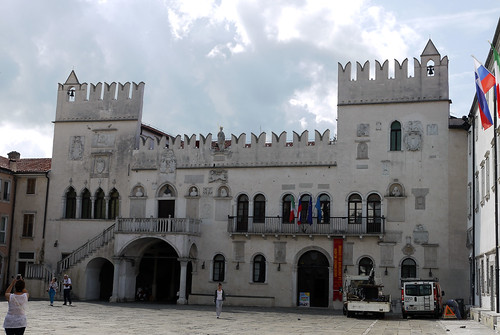Koper is one of the oldest and most (unjustifiably) overlooked Slovene towns. The majority of people speeding past Koper on their way to Piran and Portorož only see the unattractive cranes of the Koper port from the road. But they do not know that a wonderful and lively old town center hides there. The long-standing rule of the Venetian Republic has left a fantastic architectural heritage, which is definitely worth a visit. Explore the narrow streets of Koper, discover its numerous squares and mingle with the locals, which are far more common here than tourists.
Koper or Capo d’Istria (the head of Istria) used to be an island and a salt panning town. Its origins go as far back as the Roman era; but the Venetian Republic has left the most prominent stamp, which was the time when this town economically and culturally blossomed. With the downfall of the Venetian Republic and the construction of the railway Trieste-Vienna, Koper lost its significance slightly. Nevertheless, after the 2nd World War it started to develop persistently and in time it has become the economic capital of the coastal region and an important port town.
The main attraction in Koper is Tito Square which is surrounded on all four sides by beautiful architecture, one of which is the former Praetorian Palace.
The Praetor’s Palace closes off the south edge of the central Koper Square. A storey palace with an exterior staircase and two elevated tower-like wings on the east and west dominates the side of the square.
It is the most representational secular building in the city. With its late Gothic Renaissance facade and different inner areas it reaches the top of secular palaces of its time in Slovenia. The building was constructed on the location of two older houses from the middle of the 13th century. In the second half of the 13th century the buildings were connected by a loggia and were later rebuilt several times and finalised as a building with characteristics of Venetian Gothic and all posterior remakings.
Between the tower-like edge areas there is a wide storey facade with a series of windows, a staircase and a `rizalit` balcony on the arch and two supporters, and a balcony by the hall with numerous decorative coats-of-arms, the engraved history of Koper. The cogged Ghibbeline addition was placed above the main facade in 1664. There stands Justice in stone, armed with a sword. In the building structure, the ground floor loggia is recognisable, while on the floor above we can decipher the halls of the large and small councils, several additional halls, rooms and former living quarters. The interior has been arranged for the representational needs of the municipality and fitted with period furniture in the celebration hall, offices and exhibition areas on the ground floor.
At the corner of the side facade of the palace there is a chiselled plaque with an opening, a typical Venetian “bocca del leone”, where anonymous messages for the mayor were left.












Well worth not “speeding by”. You must have been pleased to have this opportunity
We took the local bus from Piran and had an enjoyable day out.
It looks really gorgeous Cherie! I love the Praetorian Palace. You can definitely see the Venetian influence – it also reminds me a little bit of the Loggia del Consiglio in Verona.
It is a fabulous looking building